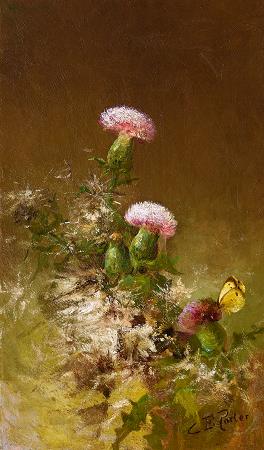
Thistle. Thistle is the common name of a group of flowering plants characterised by leaves with sharp prickles on the margins, mostly in the family Asteraceae.
Prickles can also occur all over the plant – on the stem and on the flat parts of the leaves. These prickles are an adaptation that protects the plant from being eaten by herbivores.
Typically, an involucre with a clasping shape similar to a cup or urn subtends each of a thistle's flower heads. The typically feathery pappus of a ripe thistle flower is known as thistle-down.
The comparative amount of spininess varies dramatically by species. For example, Cirsium heterophyllum has minimal spininess while Cirsium spinosissimum is the opposite.
Typically, species adapted to dry environments have greater spininess. The term thistle is sometimes taken to mean precisely those plants in the tribe Cardueae, especially the genera Carduus, Cirsium, and Onopordum. However, plants outside this tribe are sometimes called thistles. Biennial thistles are particularly noteworthy for their high wildlife value, producing such things as copious floral resources for pollinators, nourishing seeds for birds like the goldfinch, foliage for butterfly larvae, and down for the lining of birds' nests. A thistle is the floral emblem of Scotland and Lorraine, as well as the emblem of the Encyclop�dia Britannica. Carduus nutans in the early morning
Prickles can also occur all over the plant – on the stem and on the flat parts of the leaves. These prickles are an adaptation that protects the plant from being eaten by herbivores.
Typically, an involucre with a clasping shape similar to a cup or urn subtends each of a thistle's flower heads. The typically feathery pappus of a ripe thistle flower is known as thistle-down.
The comparative amount of spininess varies dramatically by species. For example, Cirsium heterophyllum has minimal spininess while Cirsium spinosissimum is the opposite.
Typically, species adapted to dry environments have greater spininess. The term thistle is sometimes taken to mean precisely those plants in the tribe Cardueae, especially the genera Carduus, Cirsium, and Onopordum. However, plants outside this tribe are sometimes called thistles. Biennial thistles are particularly noteworthy for their high wildlife value, producing such things as copious floral resources for pollinators, nourishing seeds for birds like the goldfinch, foliage for butterfly larvae, and down for the lining of birds' nests. A thistle is the floral emblem of Scotland and Lorraine, as well as the emblem of the Encyclop�dia Britannica. Carduus nutans in the early morning
Wikipedia ...